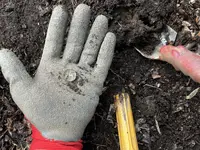Midden-marauder
Sr. Member
What is the average depth of the finds you folks make with your detectors? I'm having to dial back sensitivity on my new rig to avoid digging 12"+ on the plumbing in our yard, I've located at least 3 pipes now and I'm getting sick of digging that deep, the VDI on those rusty ass pipes rings in like silver which confuses things (most rusty iron is high numbers/tones, I'm beginning to doubt all high and low tones).
I'm sure there's special exceptions but what would you say your typical depth is? I'm trying to learn this thing and where to set things. I need perspective
I'm sure there's special exceptions but what would you say your typical depth is? I'm trying to learn this thing and where to set things. I need perspective
Last edited:
Upvote
2




 I'll have a chat with the owners; they may know a little more about what might be where....
I'll have a chat with the owners; they may know a little more about what might be where....

